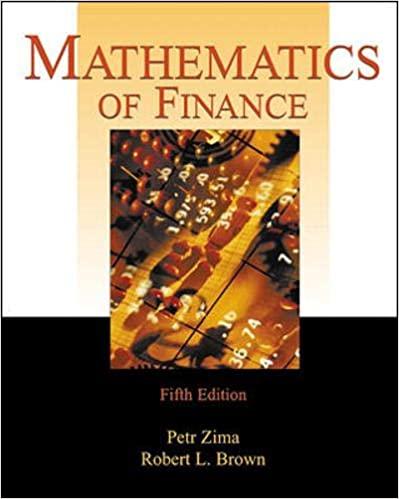Question
For each of the below, indicate True or False. No explanation is required. a) Given: At t = 0 you bought a 3-year, 9% coupon
For each of the below, indicate True or False. No explanation is required.
a) Given: At t = 0 you bought a 3-year, 9% coupon bond with a 7% YTM. You held the position until t = 3. Each coupon that was received prior to t = 3 was reinvested and rolled over at a 7% interest rate. Statement: The realized compound yield on the investment was 7%.
b) Given: At t = 0 you bought a 4-year zero coupon bond with a 9% YTM. Two years later you sold the bond when it was trading at a 12% YTM. Statement: The realized compound yield on your two-year investment was somewhere between 9% and 12%.
c) Given: At t = 0 a 10-year zero coupon bond had an 8% YTM. You bought the bond at t = 2 when it had 8 years left to maturity and was trading at a 7% YTM. You sold the bond 3 years later when its YTM was greater than 7%. Statement: Your realized compound yield from t = 2 to t = 5 was less than 7%.
d) Given: From t = 3 to t = 4 the price of a risk free bond increased, and its YTM also increased. Statement: The coupon rate on this bond must be less than the YTM. (Hint: think of the pull-to-par graph and think of whether the statement would be possible for a bond with a coupon rate greater or equal to its YTM.)
e) As a general rule, if one expects interest rates are going to surprise to the upside, it would be wiser to invest in longer term bonds.
Topic: Bond Pricing and Bond Arbitrage
2) You are given the following information:
- Bond A is a 1-year, 6% coupon bond with face value $8,000 and YTM = 4%
- Bond B is a 2-year, zero coupon bond with face value $30,000 and YTM = 6%
- Bond C is a 3-year, 7% coupon bond with face value $20,000 and YTM = 7%
- Bond D is a 4-year, zero coupon bond with face value $8,000 and YTM = 9%
- Bond E is a 5-year, zero coupon bond with face value $2,000 and YTM = 11%
2
- A financial institution is offering the following product: the client pays the financial institution $200,000 at t = 0 and another $100,000 at t = 1 the financial institution pays the client $40,000 at t = 2, X at t = 3, and $60,000 at t = 4
a) What would X have to be in order for the product to be fairly priced? (Hint: bootstrap the yield curve and then set PV(client cash flow to bank ) = PV(bank cash flow to client).
b) Suppose a financial institution is offering the above product, but the payment at t = 3 is $100 greater than your answer to part a. You are a Hedge Fund manager. Describe how you would create an arbitrage by buying 1 unit of the product from the financial institution and trading the various bonds listed above at t = 0 (you may not have to trade all of them). Specify how many units of each bond you will buy or sell. Construct the arbitrage so that your profit is realized at t = 0.
c) Based on your strategy in part b, what is the magnitude of the arbitrage profit at t = 0?
d) Repeat part b, but this time construct the arbitrage in such a way that the profit is realized at t = 3. Hint: in this case your inflow = outflow conditions should hold for t = 0, 1, 2 and 4.
e) Based on your strategy in part d, what is the magnitude of the arbitrage profit at t = 3?
f) What is the relationship between your answers to parts c and e?
Step by Step Solution
There are 3 Steps involved in it
Step: 1

Get Instant Access to Expert-Tailored Solutions
See step-by-step solutions with expert insights and AI powered tools for academic success
Step: 2

Step: 3

Ace Your Homework with AI
Get the answers you need in no time with our AI-driven, step-by-step assistance
Get Started


